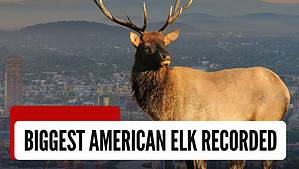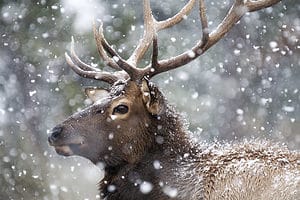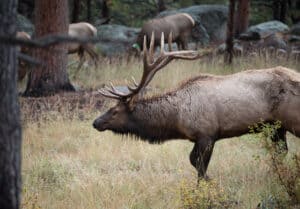Ever wondered what the difference between elk and moose poop? If you love trekking, hunting, or merely exploring the wild, you may have come across some pellet-shaped droppings while out in the great outdoors. But have you ever wondered which creature, between elk and moose, was responsible for leaving them behind?
These two of North America’s largest ungulates can share the same territory, making it challenging to tell their feces apart. We’ve compiled a list of six foolproof techniques to help you distinguish elk poop from moose poop.
Moose vs. Elk Scat: Six Unique Characteristics
Appearance
Both animals have pellet droppings, but their appearance can change depending on the season and diet. During the summer months, moose consume an array of tree leaves, aquatic plants, and young twigs, resulting in their droppings’ wetter, patty-like appearance. As the seasons shift and their diet changes, these feces become soft clumps and, ultimately, pellets.
Meanwhile, elk have dry pellet-like droppings in the winter, although generally drier than their moose counterparts.
Shape
Moose feces are characterized by roundness with tapered ends, while elk scat possesses a more elongated form with rounded edges. Moreover, the sheer size of both types of droppings is noticeably larger than that of their ungulate counterparts. Therefore, distinguishing between them is not difficult, even if their shapes appear alike.
Size
Moose have a huge body mass that can reach nearly 1,400 pounds. Their impressive stature is further amplified by their length, which can easily exceed 10 feet. Comparatively, elks’ length rarely surpasses eight feet. Due to their size discrepancy, moose poop is typically larger compared to elk poop. Moose feces can vary in size from 0.6 to 0.8 inches, while elk droppings typically range from 0.4 to 0.6 inches.
Color
Moose poop is generally darker than elk poop, varying in color from green to black. The color depends on the season and the food they eat. When moose eat more green vegetation in summer, their poop is greener. When they eat more woody materials in winter, their poop is blacker.
Elk feces vary in color from greenish to dark brown. The color also depends on the season and the food they eat. When elks eat more grasses and other vegetation in summer, their poop is lighter. When they eat more bark and twigs in winter, their poop is darker.
Consistency
The consistency of the scat can also give you some clues about the animal. Moose and elk poop are made of similar materials throughout. Elk poop is generally drier and harder than moose poop, as elks have a more efficient digestive system that extracts more moisture from their food. Moose poop is wetter and softer, especially in summer when they eat more succulent plants.
Content
The content of the scat can reveal what the animal ate and where it lives. Moose scat mainly contains tree materials, such as leaves, twigs, bark, and needles; this indicates that moose live in coniferous forests or near water sources where they can find aquatic plants. Elk scat contains more grasses and other vegetation, such as berries and fruits, thereby indicating that elks live in open areas or mixed forests where they can find a variety of food sources.

This majestic moose is standing tall in its natural habitat. With antlers that can span up to 6 feet from end to end, it is an impressive sight!
©Tom Tietz/Shutterstock.com
Background Information on Elks
Elks are among the heaviest deer in the world. They can weigh up to 1000 pounds for males and 600 pounds for females. Their weight varies depending on the season and the availability of food.
Male elks have impressive antlers that can grow up to 4 feet long and weigh up to 40 pounds. They use their antlers for fighting and attracting mates. They shed their antlers yearly in late winter or early spring and grow new ones in summer.
Elks’ thick fur protects them from cold and predators — their fur color changes with the seasons. In summer, they have a reddish-brown coat and a darker brown coat in winter. They also have a long mane on their neck and chest that helps them conserve heat.
Habitat and Distribution
Elks prefer woodlands but can also be found in open mountains, coniferous swamps, and hardwood forests. They thrive in young or disturbed forests with abundant new plant life but also need closed-canopy forests for cover and forage in late summer. Elks avoid boreal forests, tundra, and deserts. Forest habitats provide elks with shelter, security, and thermal regulation.
Elks also graze on grasses, sedges, and forbs in alpine meadows, semi-deserts, and plains. Grassland habitats provide elks with abundant and nutritious food sources, especially in spring and fall. However, grassland habitats also expose elks to predation risk and human disturbance.
Elk populations can be found in several states in North America, including Oregon, Washington, Wyoming, Montana, California, Idaho, Arizona, Utah, New Mexico, Nevada, and Colorado. They are also present in Canada and have been reintroduced to some eastern states. They’re also called wapiti in some regions.
Behavior and Social Structure
Elks are social animals that dwell in herds of varying sizes and compositions depending on the season and the habitat. Throughout the year, elks segregate via intercourse and age, with females forming agencies of 10 to twenty people with their offspring. Males shape smaller herds or stay on their own. However, at some stage in the mating season (also referred to as rut), which happens from late August to mid-October, elks congregate in larger combined-sex groups.

A majestic elk stands proud and tall near a tranquil lake. Its antlers span several feet, making it an impressive sight to behold.
©Cody Linde/Shutterstock.com
Mating season is a period of extreme competition and connection amongst elks. Male elks attempt to appeal to the females through bugling (a noisy vocalization that may be heard up to a mile away), showing their antlers, and combating different males. The dominant male elk (referred to as a bull) establishes a territory (called a harem) in which he gathers several females (also known as cows) and buddies with them.
The bull defends his harem from other adult males by chasing them away or challenging them to violent clashes, which can result in critical accidents or death. Female elks give birth to one calf (rarely two) after a gestation period of about eight months. The calf is born with spots that help it camouflage in the vegetation. The calf stays with its mother for about a year until she gives birth again.
Diet
Elks are ruminants, meaning they have a four-chambered stomach that allows them to digest tough plant material. Elks eat distinct plant life sorts relying on the season and the provision of food assets. In popular, while they’re considerable and nutritious, elks feed on grasses and forbs (herbaceous flowering plants) in the spring and summer. In the autumn and winter, elks transfer to shrubs, twigs, bark, and conifer needles, which are less palatable but highly available.
Elks generally consume a variety of food each day to satisfy their energy needs. On average, an elk will consume about 3 pounds of food for every hundred kilos of its weight. Elks need water to stay hydrated, especially during hot and dry conditions. Elks can drink up to four gallons of water per day.
Elks are selective feeders, meaning they select only the best meals to be had in their habitat. Elks also can adapt their diet to new food sources introduced by people, which include hay fields, gardens, orchards, and crops.
Who Eats Elks?
Elks are preyed upon by various carnivorous animals that share their range. The most common predators of elks are:
These predators can kill adult elks and calves but usually target young, sick, or injured ones that are easier to catch. Wolves hunt elks in packs, using teamwork and strategy to isolate and chase down their prey. Mountain lions stalk elks from a distance, using stealth and ambush to pounce on them from behind. Bears scavenge on elk carcasses left by other predators or kill elks by overpowering them with their strength and claws.
Other predators of elks include coyotes and bobcats. These predators usually prey on elk calves during the birthing season, when they are vulnerable and separated from their mothers. Coyotes and bobcats use speed and agility to catch elk calves in open areas or dense cover. Humans hunt elks for sport or subsistence, using firearms or bows and arrows. In Asia, elks also face predation from Siberian tigers.
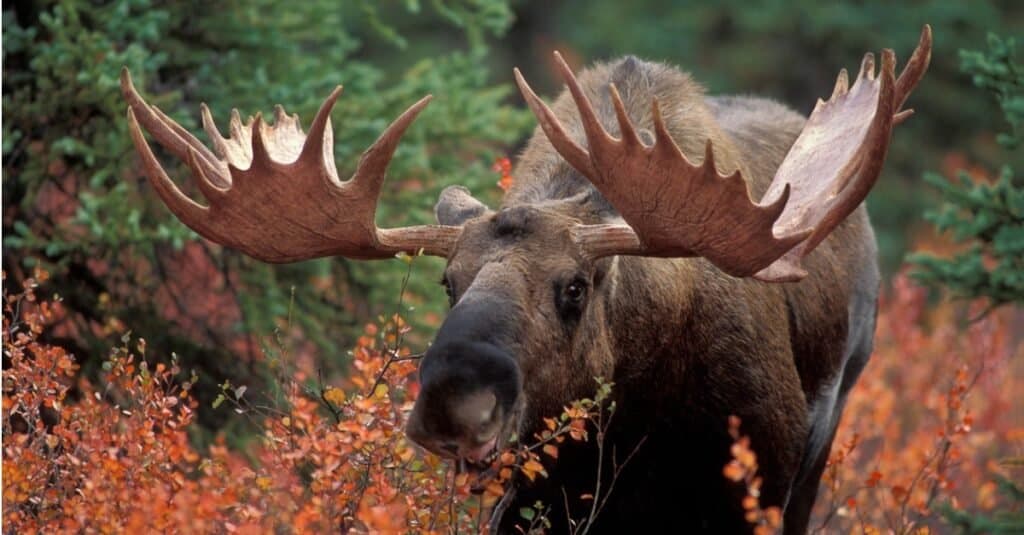
A massive moose stands majestically amongst the spring wildflowers of a Rocky Mountain national park, its size and presence adding beauty to the landscape.
©iStock.com/RONSAN4D
How Long Do Elks Live?
Elks can live for 10 to 13 years in the wild. Some elks can live longer, up to 18 or 20 years in captivity. But many elks die sooner because of hunters, predators, diseases, or lack of food. Elks also have problems with their teeth because they eat plants with too much fluoride and silica. These substances make their teeth wear out faster, making it hard for them to eat.
Are Elks Endangered?
Elk are not endangered animals. The International Union for Conservation of Nature (IUCN) says elk are not at risk of extinction because they have a wide distribution and their population is growing. There are more than 750,000 elk today in the U.S. and Canada.
Background Information on Moose
Moose are larger than elks and can tower over two meters (or 6.9 feet) when standing on their hind legs. They can weigh up to seven hundred kilograms (equivalent to 1,500 pounds). The antlers of male moose are a sight to behold, developing up to 1.8 meters (or six feet) in width.
Moose additionally boast a thick, lustrous coat of fur that varies in hues from darkish brown to black, with some white patches on their legs. This fur serves as a means of temperature regulation and protects against pesky insects and parasites.
Habitat and Distribution
Moose dwell in habitats that are abundant in food, water, and shelter. You’re most likely to find them in mountainous regions, tundra, wetlands, and boreal forests. They can tolerate cold climates well but suffer from heat stress in warmer temperatures.
Moose have a wide geographic range in North America, from Alaska to Newfoundland in Canada and Maine to Washington in the United States. They’re prevalent in northern Europe and Asia. Moose migrate seasonally depending on the availability of food and water sources. They tend to move to higher elevations in summer and lower elevations in winter.
Behavior and Social Structure
Moose are mostly solitary animals, except during the late summer or early fall mating season. Males compete for females by fighting with their antlers or making loud grunts and bellows.
Females give birth to one or two calves in spring after a gestation period of about eight months. Calves stay with their mothers for up to a year, learning to find food and avoid predators. Moose communicate using vocalizations, body language, and scent.
Diet
Moose are browsers, meaning they feed on leaves, twigs, buds, and bark of woody plants. They prefer deciduous trees and shrubs, such as willow, birch, aspen, and maple. They also eat aquatic plants like water lilies, pondweed, and horsetail. Moose can consume up to 60 pounds of vegetation per day.
Moose have a four-chambered stomach that allows them to digest cellulose, the main component of plant cell walls. They also have a large cecum, a pouch-like organ that houses bacteria that help break down plant matter. Moose regurgitate and rechew their food several times before swallowing it completely. This process is called rumination, allowing them to extract more nutrients from their food.
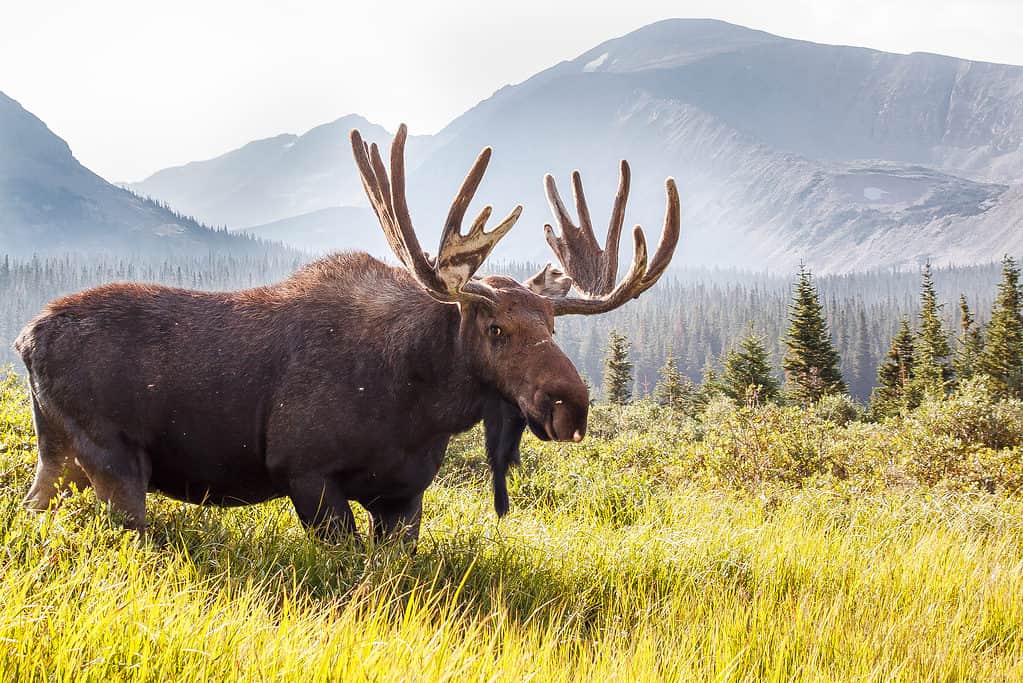
This majestic Rocky Mountain moose towers over the beautiful landscape of its natural habitat.
©Michael Liggett/Shutterstock.com
Which Animal Hunts Moose?
Moose have few natural predators, but they are not invincible. Wolves, bears, cougars, and humans are the main threats to moose survival. Wolves hunt moose in packs, using their speed and stamina to chase down and exhaust their prey. Bears ambush moose using their strength and claws to inflict fatal wounds. Cougars stalk moose from a distance, leaping on their backs and biting their necks. Humans hunt moose for sport or subsistence, using firearms or bows and arrows.
How Long Do Moose Live?
Moose have a lifespan of approximately 15 to 20 years, depending on the individual moose and its environment. The oldest recorded moose lived for 22 years. Moose in captivity tend to live longer than wild ones, as they can access veterinary care and regular feeding.
Are Moose Endangered?
Some moose populations are stable or increasing, while others are declining or threatened. For example, moose are abundant in Alaska and are hunted for food and sport. In contrast, moose face a sharp decline in Minnesota due to warmer temperatures.
Distinguishing Between Elk and Moose Droppings in the Wild
For hunters, hikers, and other nature enthusiasts venturing into the wild, distinguishing between the excrements of elk and moose can be of utmost importance. Though both creatures leave similar pellet droppings, several unique characteristics can aid in differentiation. Moose feces, for example, are typically round with tapered ends, while elk scat boasts elongated shapes with rounded tips. The color of moose droppings varies from green to black and is typically darker than the greenish to dark brown color of elk poop.
Moose droppings tend to be wetter and softer, particularly during summertime, while elk excrement is generally drier and harder. Finally, moose droppings are quite larger than elk droppings.
The photo featured at the top of this post is © iStock.com/Matt Kaminski
Thank you for reading! Have some feedback for us? Contact the AZ Animals editorial team.



